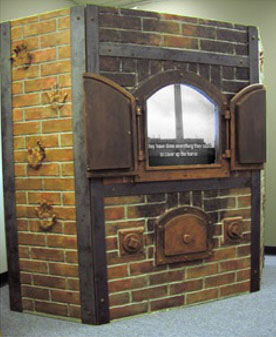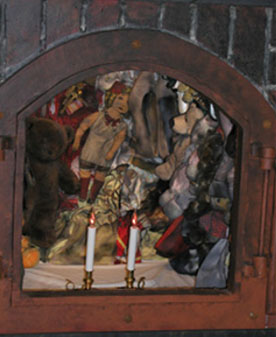Majdanek
In July 2004, I was approached by Zachariah Briggs, a Texan sculptor studying art in Chicago. Briggs was searching for an idea for his final art school project. He had read of my Digital Windows and approached me. He wanted to know if we could design a project together, incorporating one of my Digital Windows pieces into one of his sculptures.
Haunted by the Holocaust
I frequently visit the Washington, D.C. Holocaust Museum. During one of my sojourns, I watched a black-and-white movie filmed by Russian soldiers as they liberated the Nazi camp Majdanek, a Polish extermination camp. An estimated 360,000 Jews (the majority of the people in the camp), as well as many Russian prisoners of war and Poles were killed in this place.
The film's images haunted me. I was determined to illustrate the Nazis' dehumanization of their prey by showing the huge, ghastly mounds of carefully separated items stolen from the Jews: shoes, hair, gold tooth fillings, glasses, and dolls. Visions of the heart-wrenching pictures of the camps' crematoria kept me awake at night.
Creating a Kinetic Art Memorial Piece
Together, Briggs and I settled on portraying Majdanek. I obtained permission from the Spielberg Collection, which owned the movie footage, to use some segments of the film in our new Holocaust piece. Briggs constructed a replica of one of the crematoria ovens, using foam instead of concrete. Arms and legs protruded from the furnace's walls, portraying the efforts of people attempting to escape the horror.
In the furnace opening, I installed a special Digital window screen that switched from an opaque mode to a totally glass-like transparent mode. In the opaque mode, the screen fulfilled the function of a rear-projection screen, showing the black-and-white movie from the Spielberg Collection. In the transparent mode, viewers looking at the furnace's opening saw a montage of weathered objects from the World War II period—dolls, toys, human hair, shoes, glasses, pants, pens, empty wallets, cheap jewelry—that I collected from antique stores. These items represented the systematic fashion in which the heartless Nazis accumulated and organized their victims' stolen items, which they kept in storehouses for safekeeping.


Majdanek digital windows.
A more complete version of the Majdanek project is available in "My Life on the Mysterious Island of Nanotechnology" by Zvi Yaniv, available on Amazon.